Let me start writing:Transform your outdoor space into a captivating sanctuary with thoughtfully designed garden bridges that serve as both functional crossings and stunning focal points. Whether spanning a tranquil koi pond, connecting garden pathways, or simply adding architectural interest to your landscape, the right bridge can elevate your garden's aesthetic appeal dramatically. From traditional Japanese-inspired arched designs to contemporary floating structures, garden bridges offer endless possibilities for creativity and personal expression. These versatile features seamlessly blend practicality with beauty, creating memorable transitions that guide visitors through your outdoor haven while providing perfect vantage points for appreciating surrounding plantings and water features.

1. Traditional Japanese Arched Garden Bridge
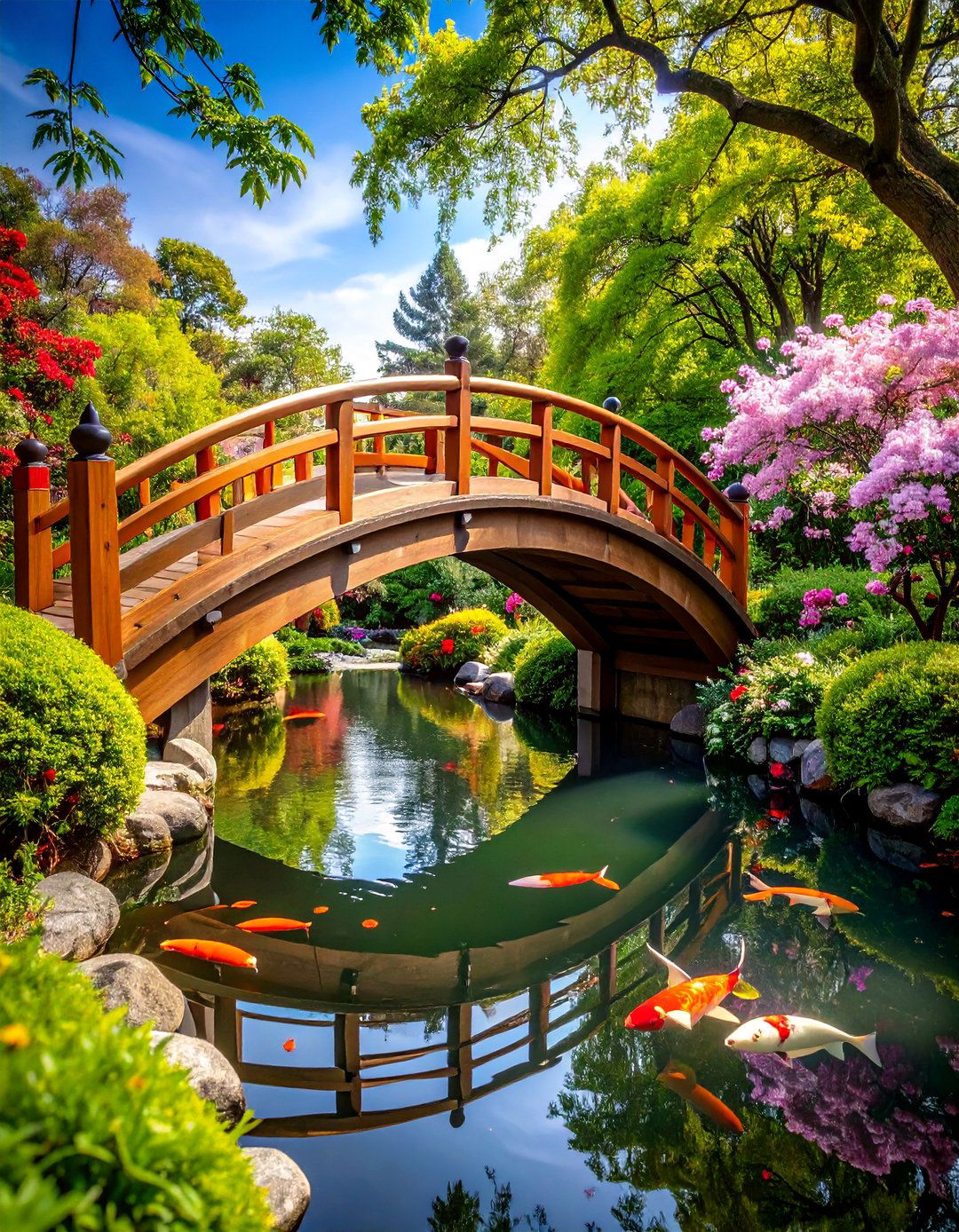
The gracefully curved Japanese arch bridge represents timeless elegance in garden design, featuring a distinctive rainbow-like profile that creates visual harmony with surrounding landscapes. Constructed from natural cedar or redwood, these bridges typically include sturdy handrails with clean lines that complement the gentle arc of the walkway. The elevated design allows for comfortable passage while providing stunning views of koi ponds, streams, or decorative water features below. Traditional red or natural wood finishes enhance the authentic Japanese aesthetic, while the bridge's proportions create perfect balance within the garden setting. This classic design works beautifully in both authentic Japanese gardens and contemporary landscapes seeking oriental inspiration.
2. Rustic Log Garden Bridge with Natural Railings
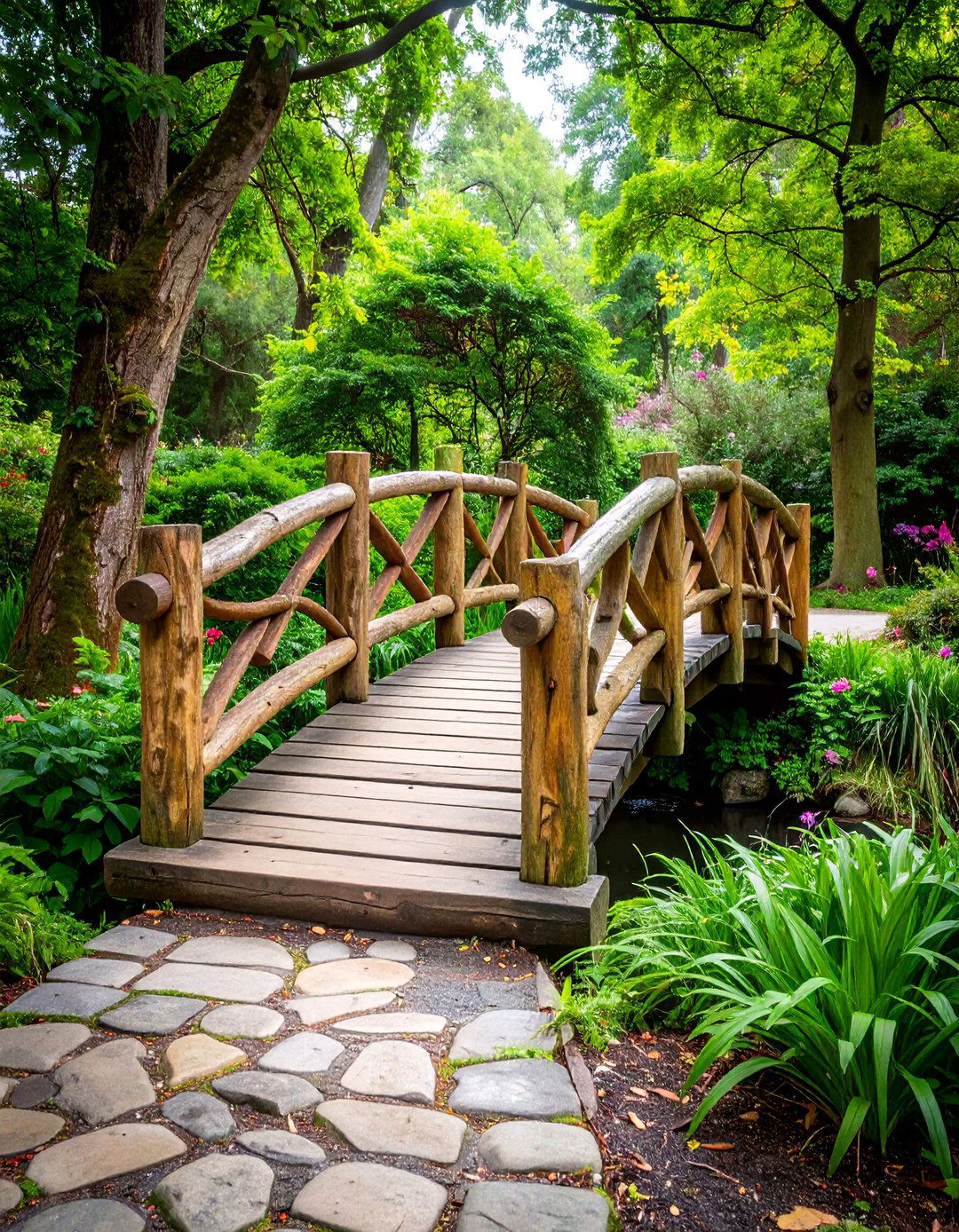
A rustic log bridge brings organic woodland charm to garden settings, utilizing whole or half-log construction that maintains the natural character of the wood. These bridges feature rough-hewn railings made from curved branches or peeled logs, creating an authentic forest atmosphere that blends seamlessly with naturalistic landscapes. The weathered appearance develops over time, adding character through natural aging processes that enhance the bridge's rustic appeal. Construction typically involves locally sourced timber, making each bridge unique in texture and grain patterns. This design perfectly complements cottage gardens, woodland settings, or any landscape where natural, unrefined beauty takes precedence over formal architectural elements.
3. Modern Floating Stone Slab Bridge

Contemporary floating stone bridges create the illusion of walking on water through carefully positioned granite or limestone slabs that appear to hover above the surface. Each massive stone is strategically placed to ensure proper spacing for comfortable walking while maintaining visual lightness through minimal contact with the water below. The clean, geometric lines of rectangular or square slabs provide striking contrast against organic pond shapes and flowing water features. This minimalist approach emphasizes material beauty and precise placement rather than ornate decoration. The design works exceptionally well in modern gardens, zen spaces, or contemporary landscapes where simplicity and sophisticated restraint define the overall aesthetic direction.
4. Decorative Metal Garden Bridge with Scrollwork
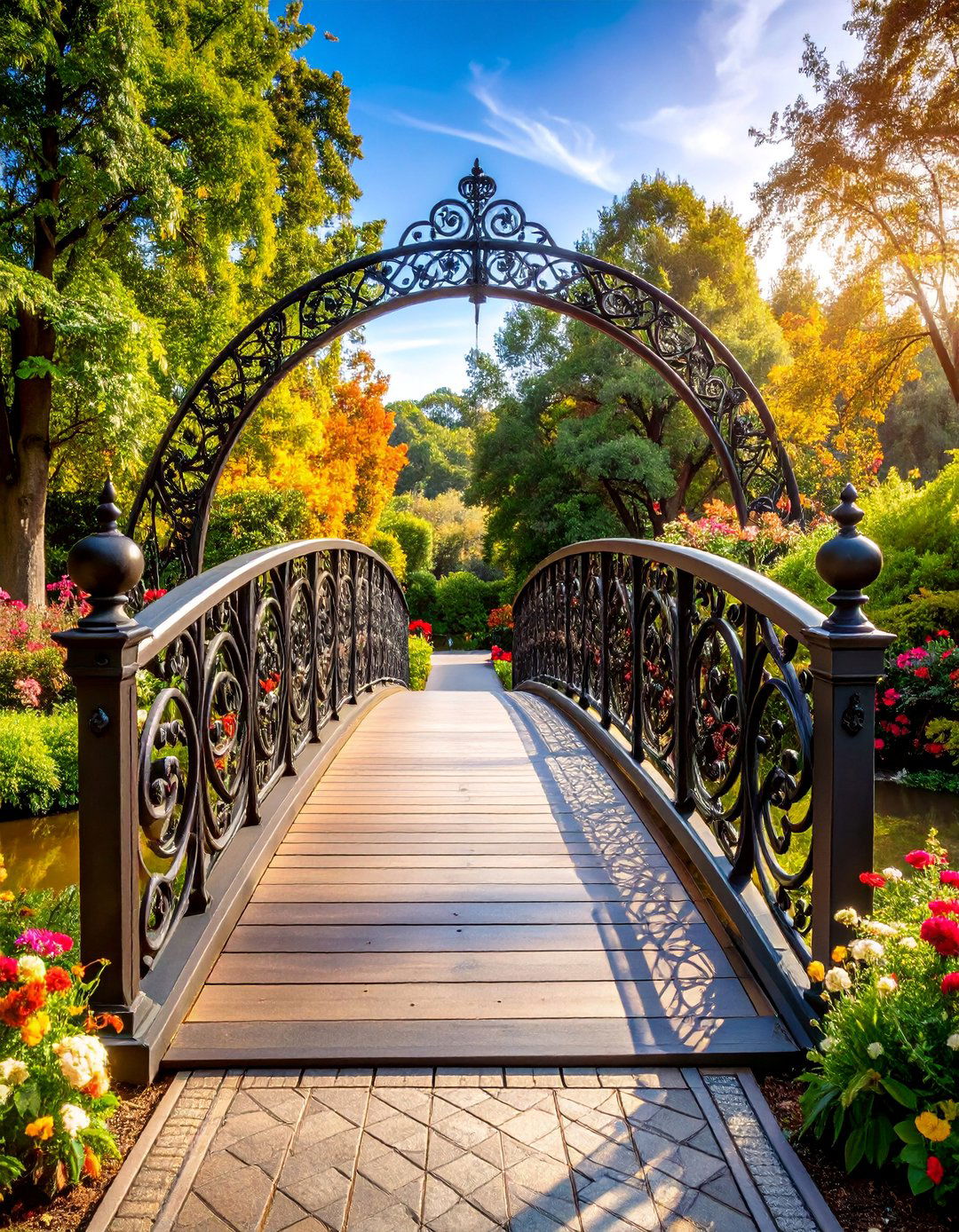
Ornate metal bridges featuring intricate scrollwork and decorative patterns add sophisticated elegance to formal garden settings. Crafted from wrought iron, aluminum, or steel, these bridges showcase detailed metalwork including floral motifs, geometric designs, or classical architectural elements. The combination of functional structure with artistic ornamentation creates stunning focal points that command attention while maintaining practical functionality. Powder coating in traditional black, deep green, or bronze finishes ensures weather resistance and longevity. These bridges complement Victorian gardens, formal landscape designs, or any setting where architectural detail and craftsmanship are valued. The decorative elements cast beautiful shadows that change throughout the day, adding dynamic visual interest.
5. Bamboo Garden Bridge with Rope Handrails

Sustainable bamboo construction offers an eco-friendly bridge solution that brings tropical flair and natural warmth to garden environments. The lightweight yet surprisingly strong bamboo poles create an airy, organic appearance that harmonizes beautifully with lush plantings and water features. Natural rope handrails woven between bamboo posts provide safety while maintaining the bridge's rustic, tropical character. The golden honey tones of bamboo develop a beautiful silver patina over time, creating an ever-evolving aesthetic that celebrates natural aging processes. This design works perfectly in tropical gardens, zen spaces, or any landscape where sustainable materials and casual elegance are prioritized over formal architectural statements.
6. Stone Stepping Stone Bridge Pathway
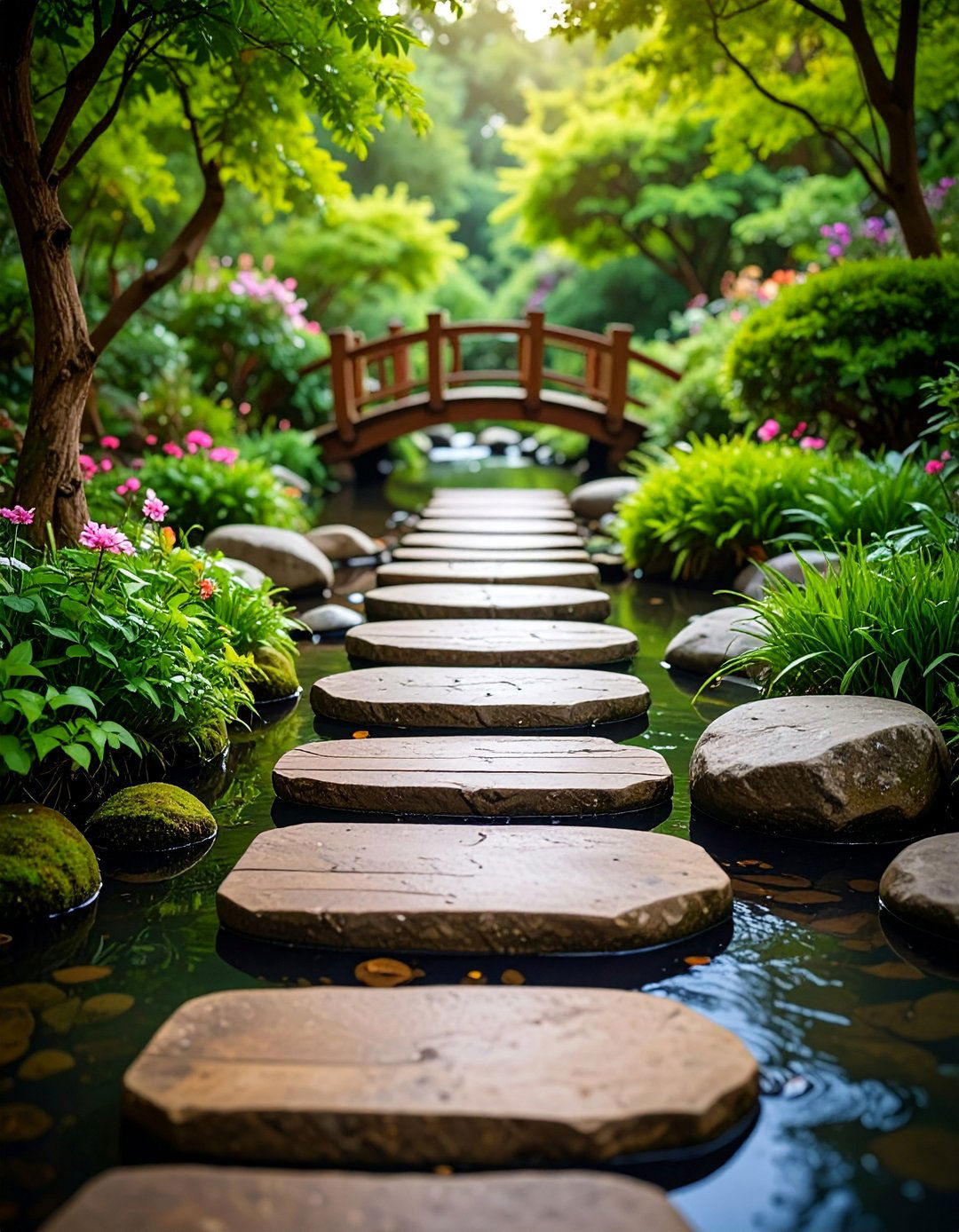
Individual stepping stones arranged across water features create an interactive crossing experience that engages visitors in mindful movement through the garden. Large, flat stones of varying shapes and sizes are positioned to accommodate natural walking patterns while creating visual rhythm across the water surface. Each stone can be selected for unique characteristics including color variations, surface textures, or interesting geological features that add personality to the crossing. This ancient design concept requires careful attention to spacing and height for safety and comfort. The stepping stone bridge encourages slower movement, allowing visitors to appreciate surrounding water plants, fish, or reflections in the water below.
7. Wooden Wagon Wheel Garden Bridge

The charming wagon wheel bridge combines rustic American heritage with practical garden functionality, featuring authentic or replica wagon wheels as distinctive railing elements. Weathered wood planking creates the walking surface, while split wagon wheels mounted vertically provide unique handrails that celebrate agricultural history. The spoked wheel design creates interesting shadow patterns while maintaining open views through the railing structure. This design works beautifully in country gardens, farmhouse landscapes, or anywhere rustic Americana themes are celebrated. The bridge can be stained or painted to match existing garden structures, while the wheel elements add whimsical character that appeals to visitors of all ages seeking nostalgic garden experiences.
8. Glass Panel Garden Bridge with Steel Frame

Ultra-modern glass panel bridges offer transparency and contemporary sophistication through tempered glass panels supported by sleek steel or aluminum frameworks. The invisible barrier effect allows unobstructed views of water features and plantings below while providing secure passage across garden elements. Structural elements are minimized to emphasize the floating effect of the clear panels, creating dramatic visual impact in contemporary landscape settings. Safety considerations include non-slip surface treatments and sturdy handrails integrated into the minimal framework design. This cutting-edge approach works best in modern gardens, architectural landscapes, or spaces where technology and nature intersect. Evening lighting creates spectacular effects through the transparent materials.
9. Curved Garden Bridge with Built-in Planters

Innovative curved bridges incorporating integrated planter boxes transform functional crossings into living architectural elements that support additional garden displays. The gentle arch design includes custom-built planters along the railings or at bridge ends, allowing for seasonal flower displays, trailing plants, or small shrubs that enhance the bridge's integration with surrounding landscapes. These planters can be designed for specific plant types, including water-loving species, fragrant herbs, or colorful annuals that change with seasons. The combination of structural beauty with horticultural opportunity creates dynamic garden features that evolve throughout the growing season while maintaining year-round architectural interest and functionality.
10. Suspension Garden Bridge with Cable Design
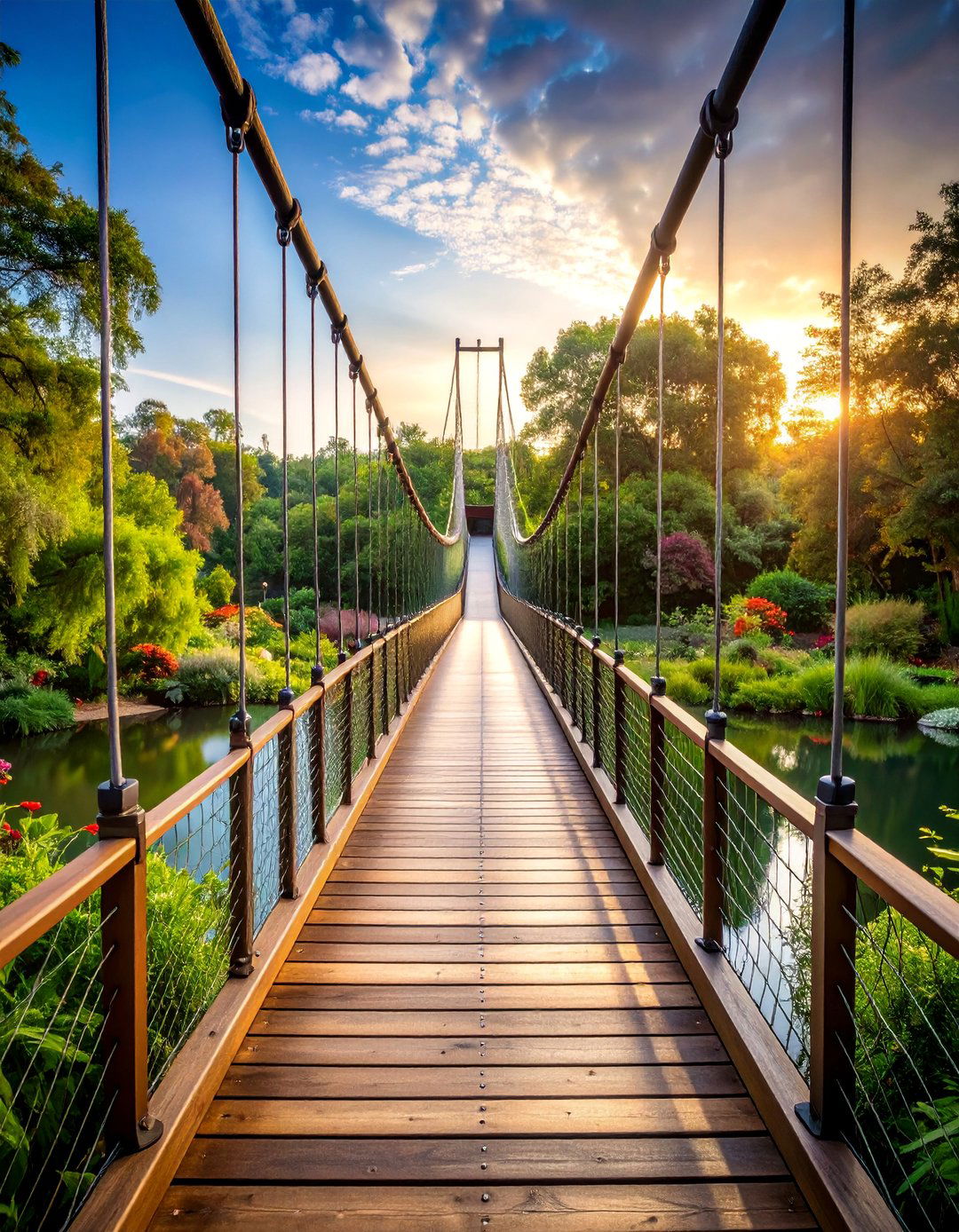
Adventure-inspired suspension bridges bring excitement and dynamic movement to garden settings through cable-supported designs that create gentle swaying motion during crossing. Steel cables anchored to sturdy posts support wooden deck planking, while additional safety cables form handrails that ensure secure passage. The engineering creates an engaging crossing experience that appeals to families with children while adding dramatic architectural interest to garden landscapes. This design works particularly well over larger water features, ravines, or between elevated garden areas. The industrial aesthetic of cables and hardware contrasts beautifully with natural garden elements, creating visual tension that enhances the overall landscape composition and visitor experience.
11. Zigzag Garden Bridge in Japanese Style
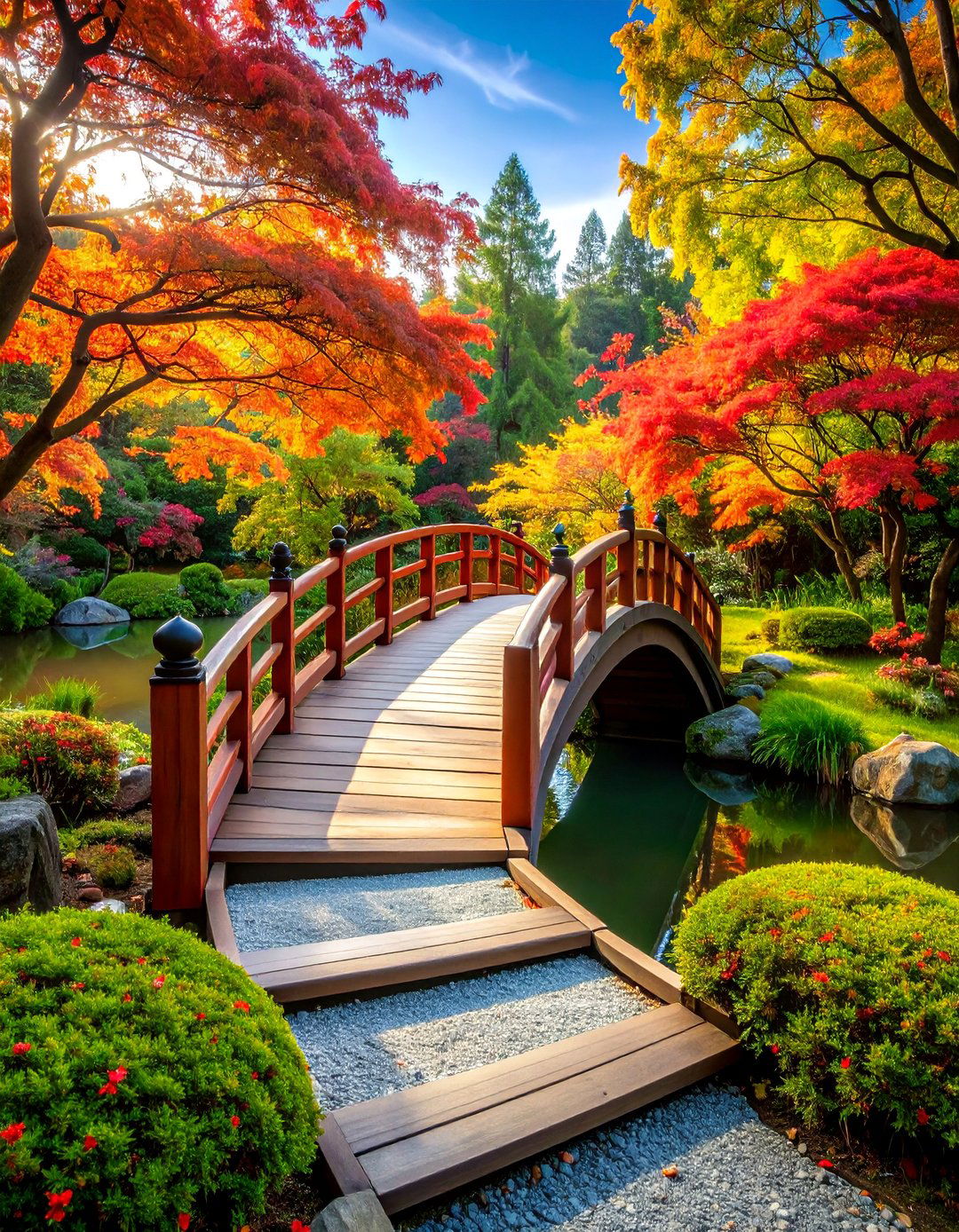
The traditional zigzag bridge design slows visitor movement while providing multiple viewing angles of surrounding garden features through its distinctive angular pathway pattern. Multiple connected segments create sharp turns that encourage contemplative walking while preventing straight-line passage that might disturb the garden's peaceful atmosphere. Each segment can be constructed from stone slabs, wooden planks, or mixed materials that complement the garden's overall design theme. This ancient Japanese concept enhances meditation and mindful observation by requiring visitors to pause and navigate each turn thoughtfully. The geometric pattern creates strong visual interest while serving the practical purpose of connecting garden areas across water features or decorative elements.
12. Miniature Decorative Garden Bridge
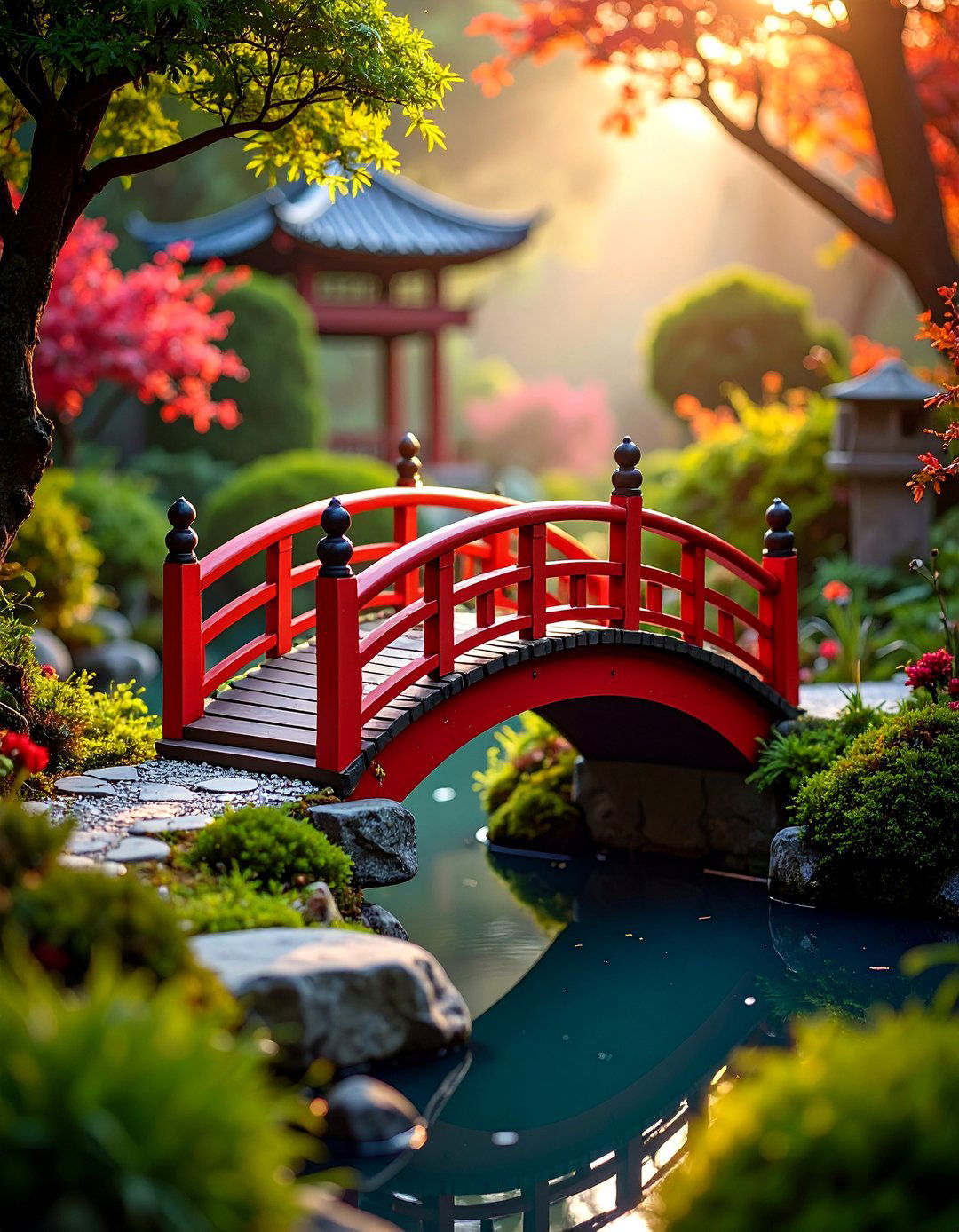
Small decorative bridges designed purely for visual impact rather than practical crossing add charming focal points to container gardens, small ponds, or intimate landscape vignettes. These scaled-down structures typically measure 2-4 feet in length and feature proportionally detailed railings, arch designs, or decorative elements that mirror full-size bridge construction. Materials can include painted wood, decorative metal, or stone, depending on the desired aesthetic effect and surrounding garden style. These miniature bridges work beautifully in fairy gardens, Japanese-inspired container displays, or as accent pieces near water features. Their small scale allows for intricate detail work and seasonal decoration changes that would be impractical on larger structures.
13. Concrete Garden Bridge with Textured Finish

Durable concrete construction offers longevity and design flexibility through custom forming techniques that create unique surface textures, patterns, or architectural details. The material can be colored, stamped, or finished to mimic natural stone, wood grain, or geometric patterns that complement specific garden styles. Concrete's versatility allows for curved forms, integrated lighting elements, or custom handrail designs that would be difficult to achieve with other materials. The substantial appearance conveys permanence and stability while requiring minimal maintenance over decades of use. This approach works well in contemporary gardens, formal landscapes, or anywhere long-term durability and design consistency are priorities over natural material aesthetics.
14. Rope and Wood Adventure Bridge

Playground-inspired rope bridges combine sturdy wooden platforms with rope handrails and support elements, creating safe but exciting crossing experiences that appeal to active families. The rope elements provide flexibility and movement that adds sensory engagement while maintaining safety through proper engineering and construction techniques. Natural hemp or synthetic ropes weather well and develop attractive aging characteristics over time. This design encourages outdoor activity and adventure while serving practical transportation needs across garden water features or between different elevation levels. The rustic appearance fits well with naturalistic landscapes, children's garden areas, or anywhere active outdoor engagement is valued alongside traditional garden beauty.
15. Illuminated Garden Bridge with LED Lighting

Integrated LED lighting systems transform garden bridges into stunning nighttime focal points while providing essential safety illumination for evening garden enjoyment. Low-voltage LED strips can be recessed into handrails, deck edges, or support posts to create dramatic uplighting or subtle pathway guidance. Solar-powered options eliminate wiring complications while providing environmentally sustainable operation. Color-changing LEDs allow seasonal lighting themes or special event customization. The lighting design should enhance rather than overpower the bridge's daytime aesthetic, using warm white or subtle colored light to create magical evening atmosphere. This technology extends garden enjoyment hours while creating safe passage and highlighting water features or plantings below.
16. Reclaimed Wood Garden Bridge with Character
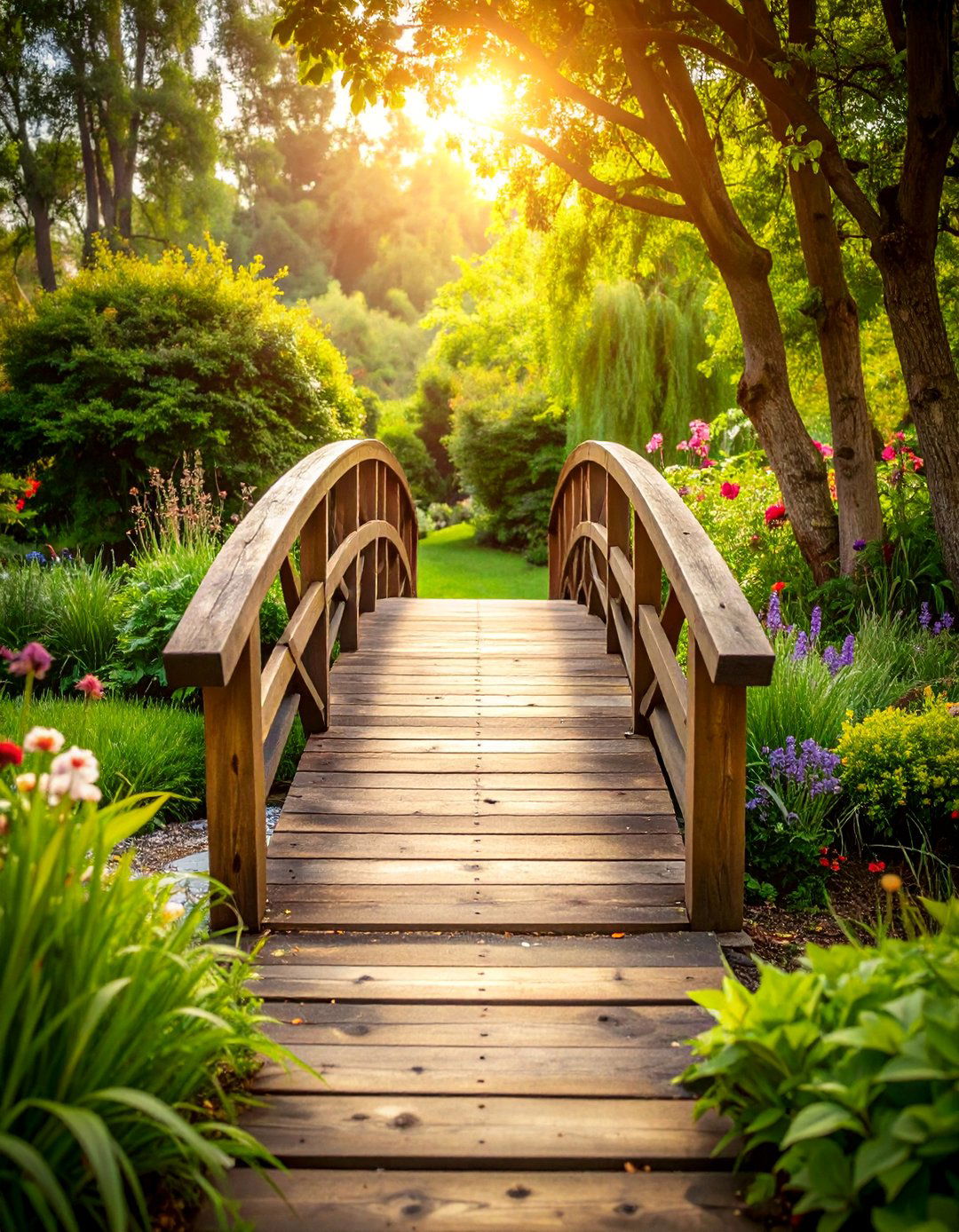
Bridges constructed from reclaimed barn wood, dock planking, or other weathered materials celebrate sustainability while adding authentic historical character to garden settings. Each piece of reclaimed wood brings unique weathering patterns, nail holes, or aging characteristics that cannot be replicated in new materials. The construction process requires careful selection and preparation of materials to ensure structural integrity while preserving desirable aesthetic qualities. This approach appeals to environmentally conscious gardeners while creating one-of-a-kind structures with genuine historical connections. The weathered appearance complements cottage gardens, rustic landscapes, or any setting where authenticity and environmental responsibility are valued over pristine new construction materials.
17. Floating Deck Garden Bridge
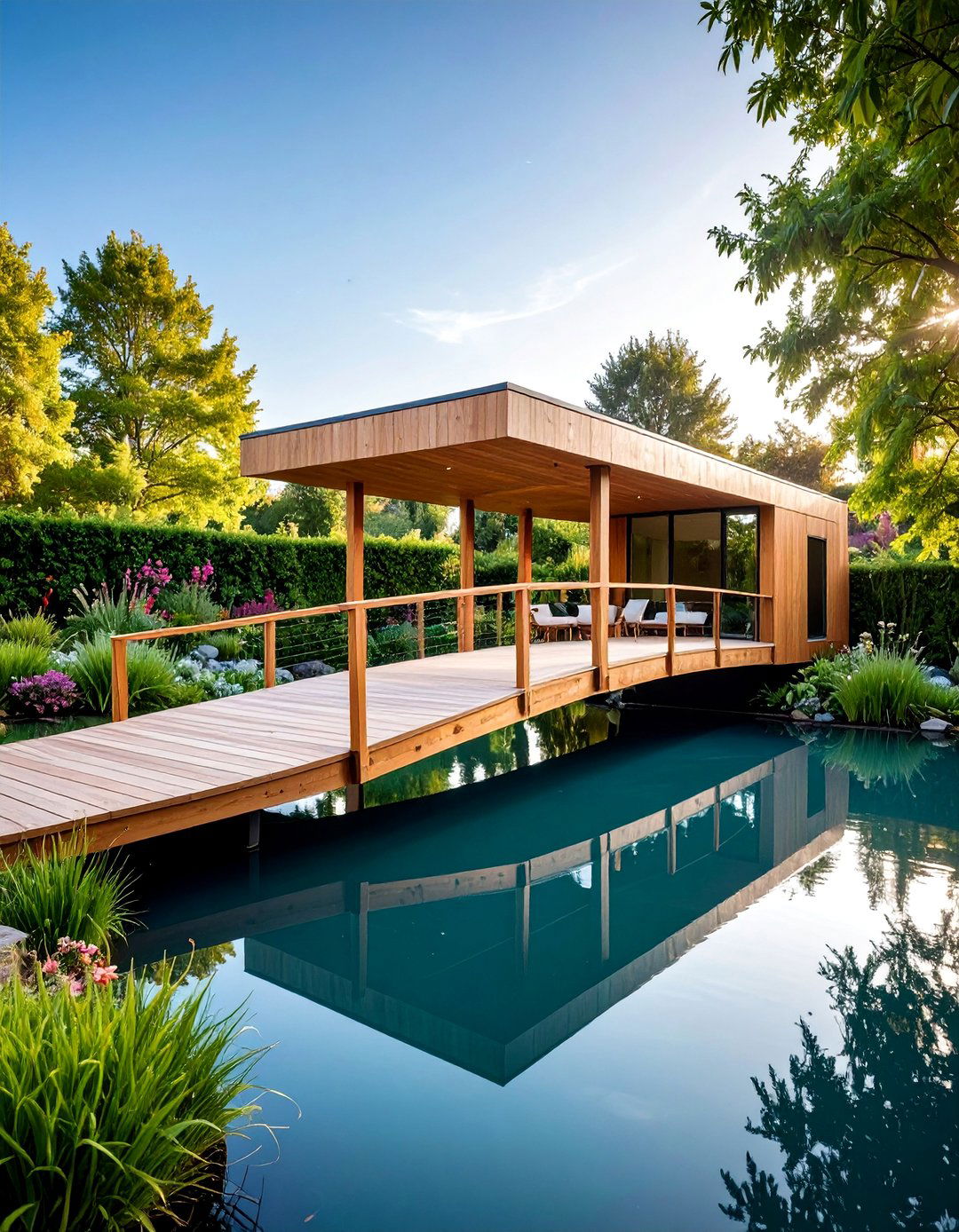
Contemporary floating deck bridges appear to hover above water surfaces through careful engineering that minimizes visible support structures while maintaining necessary stability and safety. The deck surface extends slightly beyond structural supports to enhance the floating illusion, while minimal railings preserve open sight lines across the water feature. Materials typically include pressure-treated lumber, composite decking, or metal grating that provides secure footing while allowing water views between deck boards. This modern approach works exceptionally well over large ponds, streams, or formal water features where architectural drama and contemporary design sensibilities take precedence over traditional bridge aesthetics and conventional construction methods.
18. Garden Bridge with Integrated Seating
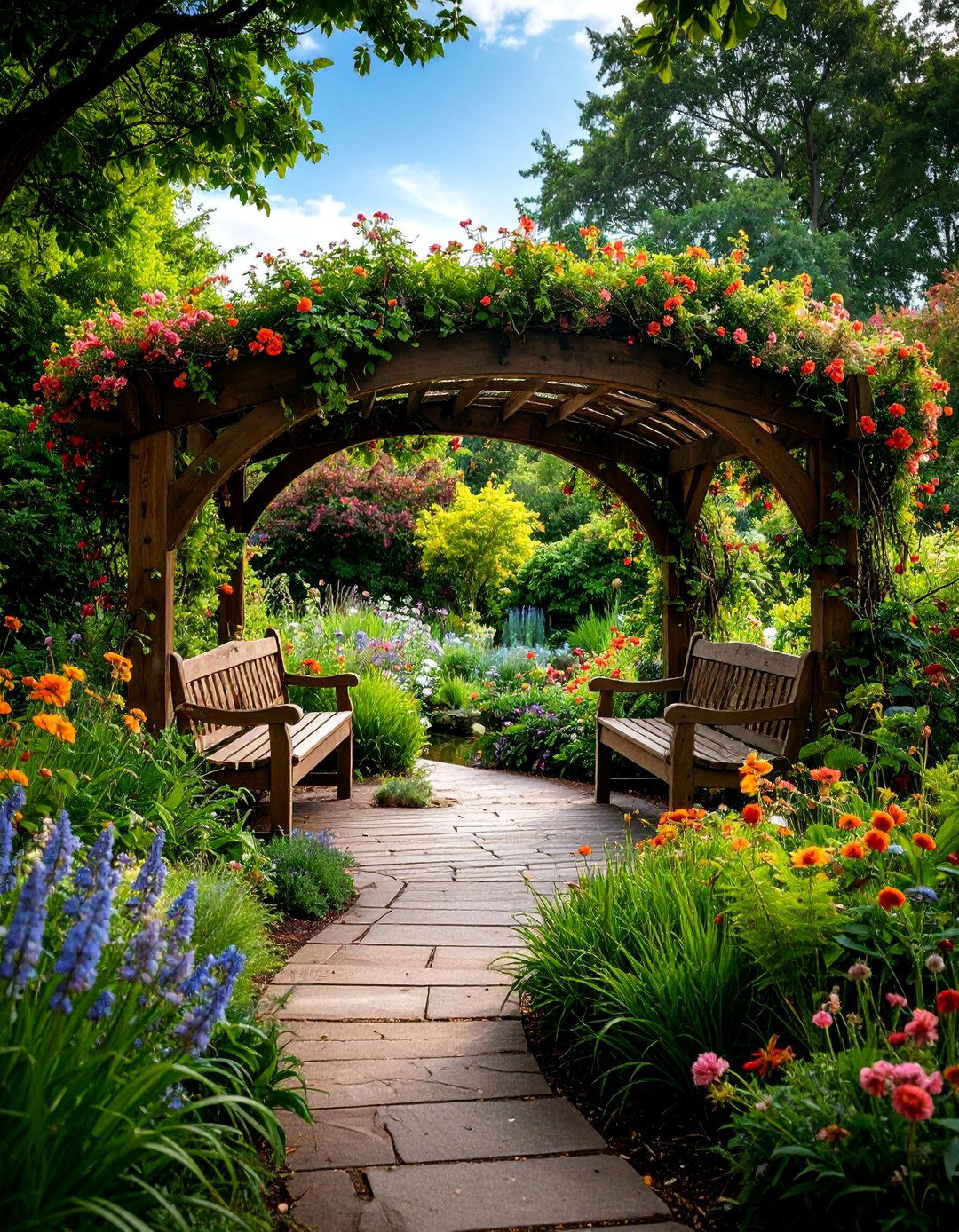
Practical bridge designs incorporating built-in benches or seating areas create rest stops that encourage longer garden visits while providing elevated viewing positions for water features and surrounding plantings. The seating can be integrated into the bridge structure itself or provided through wider deck areas that accommodate separate furniture pieces. Strategic placement allows visitors to pause mid-crossing for photography, meditation, or simply enjoying peaceful garden sounds and scenery. This design serves multiple functions while maximizing the bridge's value as both transportation infrastructure and garden amenity. The seating elements should complement the bridge's overall design style while providing comfortable proportions and weather-resistant construction for year-round outdoor use.
19. Stone Arch Garden Bridge

Classic masonry arch construction creates permanent, substantial bridges that develop beautiful weathering characteristics while requiring minimal maintenance over decades of service. The arch design distributes weight efficiently while creating graceful curves that complement both formal and naturalistic garden styles. Natural stone selection can emphasize local geological character or complement existing landscape materials, while mortar joints can be finished to highlight or minimize the individual stone elements. This traditional construction method appeals to gardeners seeking historical authenticity, substantial permanence, or integration with existing stone walls, patios, or architectural elements. The thermal mass helps moderate temperature extremes while providing habitat opportunities for beneficial moss and lichen growth.
20. Multi-Level Garden Bridge Design
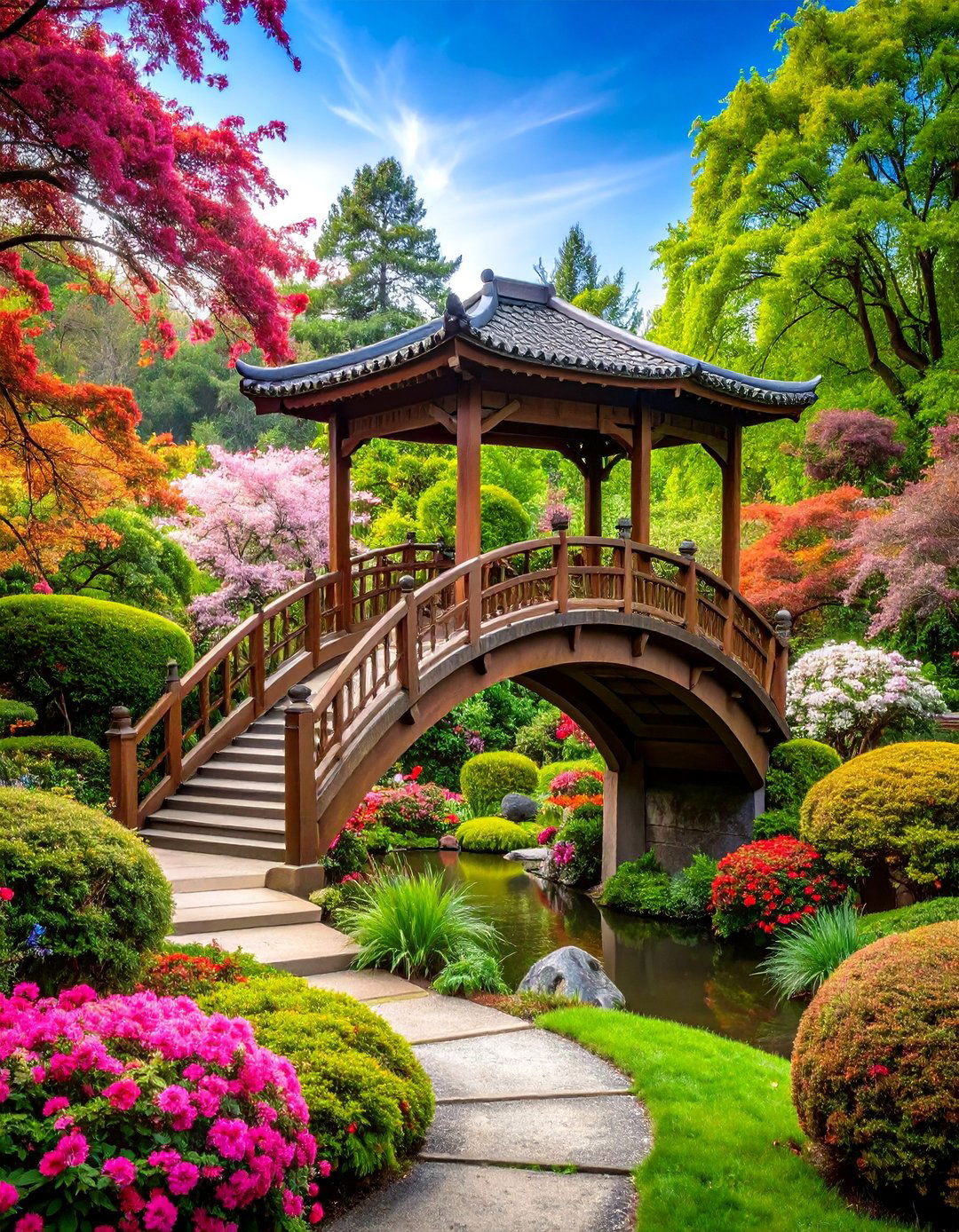
Innovative multi-level bridges create complex architectural features that serve multiple functions while adding dramatic vertical interest to garden landscapes. The design might include upper and lower walkways, integrated planters at different heights, or varying deck levels that accommodate different water depths or landscape elevations. This approach maximizes functionality while creating interesting spatial relationships and multiple viewing perspectives. The complex geometry requires careful engineering and planning but results in unique garden features that become destination points rather than simple transportation infrastructure. The multi-level concept works particularly well in larger gardens where substantial architectural elements can be proportionally appropriate to the overall landscape scale.
21. Pallet Wood DIY Garden Bridge

Budget-conscious gardeners can create attractive bridges using reclaimed shipping pallets as primary construction material, offering sustainable solutions that require basic woodworking skills and minimal financial investment. Pallets provide pre-assembled framework elements that can be modified, combined, or refinished to create custom bridge designs tailored to specific garden requirements. The industrial character of pallet construction creates interesting textural contrast with garden plantings while celebrating resourcefulness and environmental responsibility. Safety considerations require careful inspection and reinforcement of pallet construction, but the results can be remarkably attractive and functional. This approach appeals to DIY enthusiasts seeking hands-on projects that deliver professional-appearing results through creative material repurposing.
22. Garden Bridge with Trellis Integration

Bridges incorporating trellis elements support climbing plants that create living architecture while providing seasonal interest through flowering vines, fruit production, or dramatic foliage changes. The trellis structure can be integrated into handrails, overhead canopies, or side panels that frame the crossing experience with natural beauty. Plant selection might include flowering vines like clematis or wisteria, edible grapes or kiwi, or fast-growing annual vines that change seasonally. This combination of infrastructure and horticulture creates evolving garden features that mature and improve over time. The living elements provide shade, fragrance, and habitat while softening the bridge's architectural presence within the broader landscape composition.
23. Curved Metal Garden Bridge
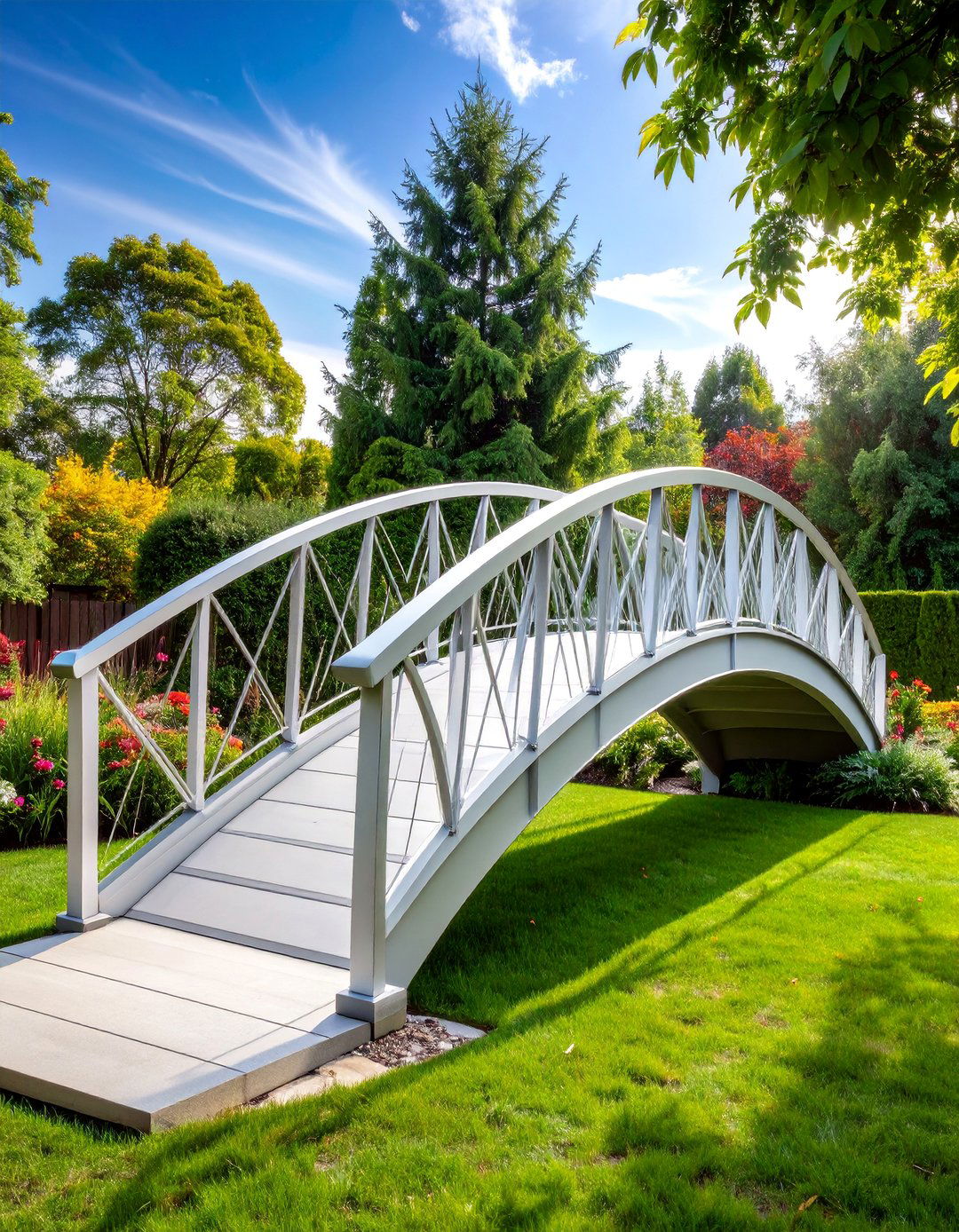
Sleek curved metal construction offers contemporary elegance while providing exceptional durability and design flexibility through custom fabrication techniques. The smooth curves can be powder-coated in colors that complement garden themes or left natural to develop attractive weathering patinas over time. Metal construction allows for minimal profile designs that appear lighter than equivalent wooden structures while supporting greater loads and spanning longer distances. The curves create graceful geometric forms that contrast beautifully with organic garden shapes while maintaining visual harmony through proportional relationships. This approach works well in modern gardens, formal landscapes, or anywhere contemporary materials and precision manufacturing are valued over traditional construction methods and natural material characteristics.
24. Zen Garden Bridge with Gravel Elements
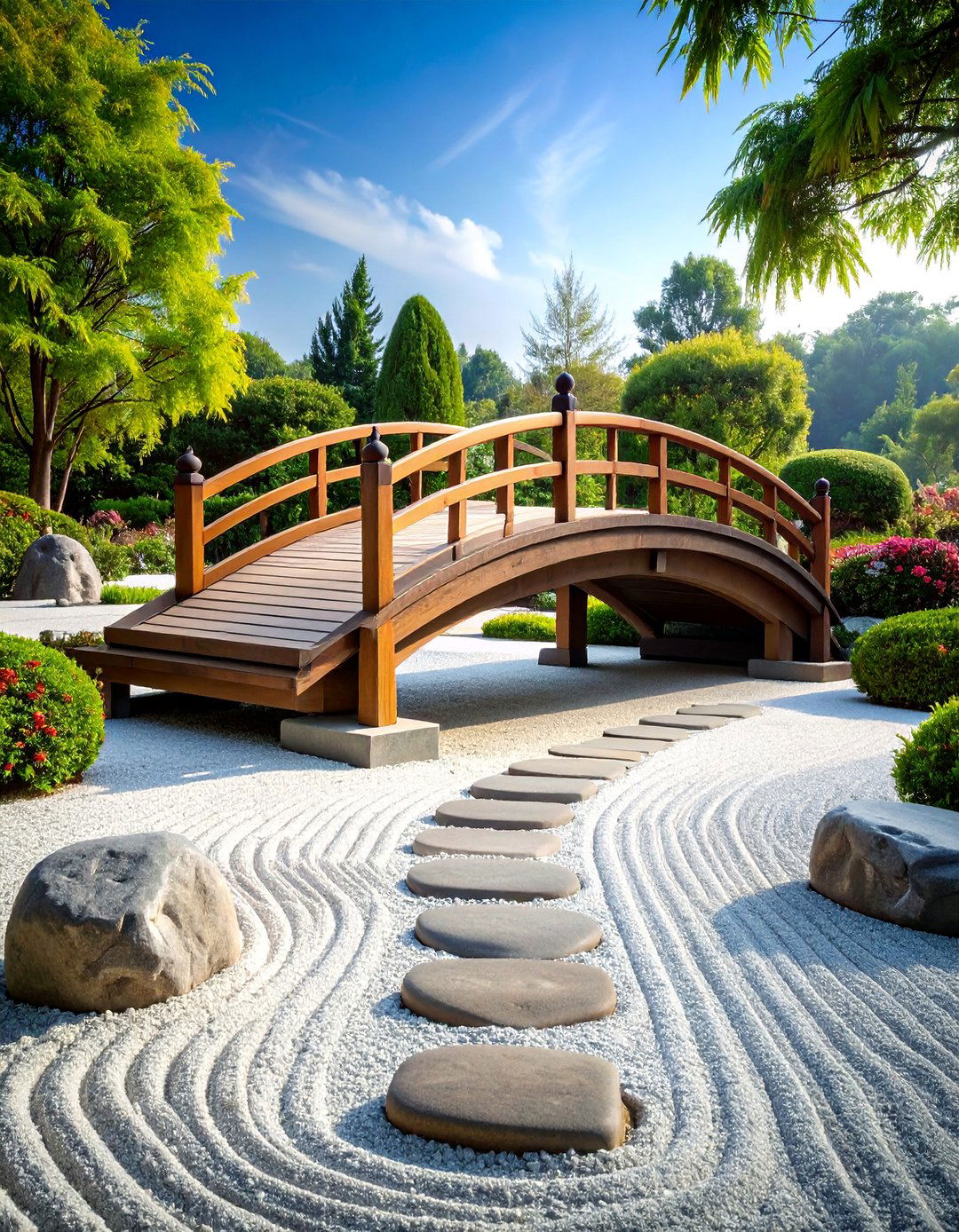
Minimalist bridges designed for zen or meditation gardens emphasize simplicity, natural materials, and integration with raked gravel patterns or stone arrangements. The bridge design might include integrated gravel sections, stone stepping elements, or minimal railings that maintain clean sight lines while providing necessary safety features. Natural materials age gracefully while developing moss, lichen, or weathering characteristics that enhance the meditative quality of the garden space. This approach prioritizes contemplative experience over decorative elaboration, creating peaceful transitions that encourage mindful movement through carefully composed landscape elements. The bridge serves as both functional infrastructure and spiritual metaphor within the broader zen garden philosophy and design aesthetic.
25. Garden Bridge with Natural Rock Integration

Bridges incorporating natural rock outcroppings or boulder formations create seamless integration between constructed elements and existing geological features within the landscape. The design works with rather than against natural topography, using rock formations as anchor points, support elements, or decorative integration that enhances both the bridge and surrounding natural features. This approach requires careful site analysis and custom design work but results in structures that appear to have emerged naturally from the landscape rather than being imposed upon it. The rock integration provides habitat for plants, interesting textural contrasts, and thermal mass that moderates temperature extremes while creating unique architectural statements.
Conclusion:
Garden bridges offer transformative potential for outdoor spaces of any size, creating functional connections while serving as stunning architectural focal points that enhance your landscape's beauty and usability. Whether you choose traditional Japanese elegance, contemporary modern designs, or rustic natural materials, the perfect bridge can dramatically elevate your garden's aesthetic appeal while providing practical crossing solutions. These versatile features encourage exploration, provide elevated viewing perspectives, and create memorable transitions that guide visitors through your carefully crafted outdoor sanctuary. The investment in a well-designed garden bridge pays lasting dividends through years of enhanced garden enjoyment and increased property value.


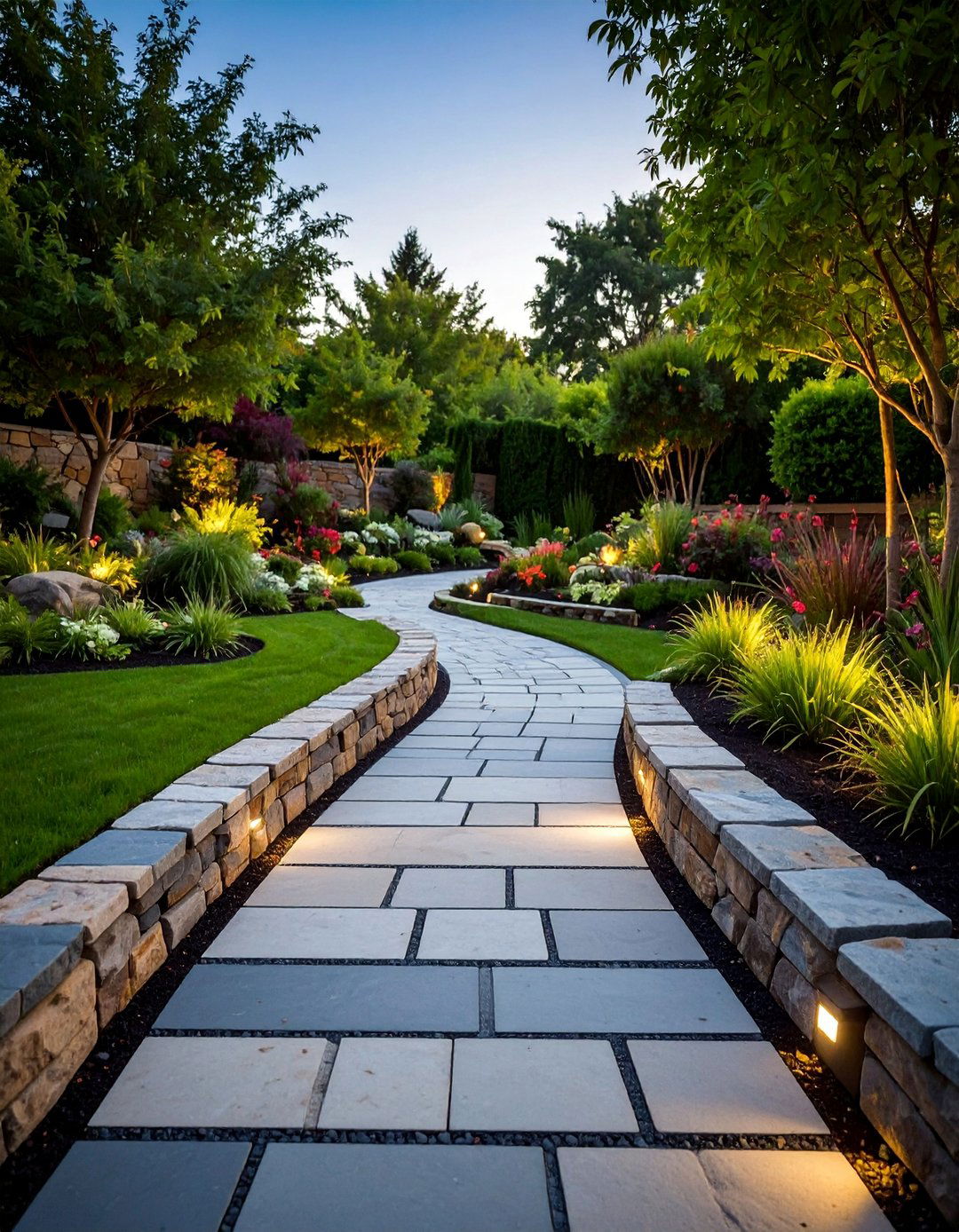
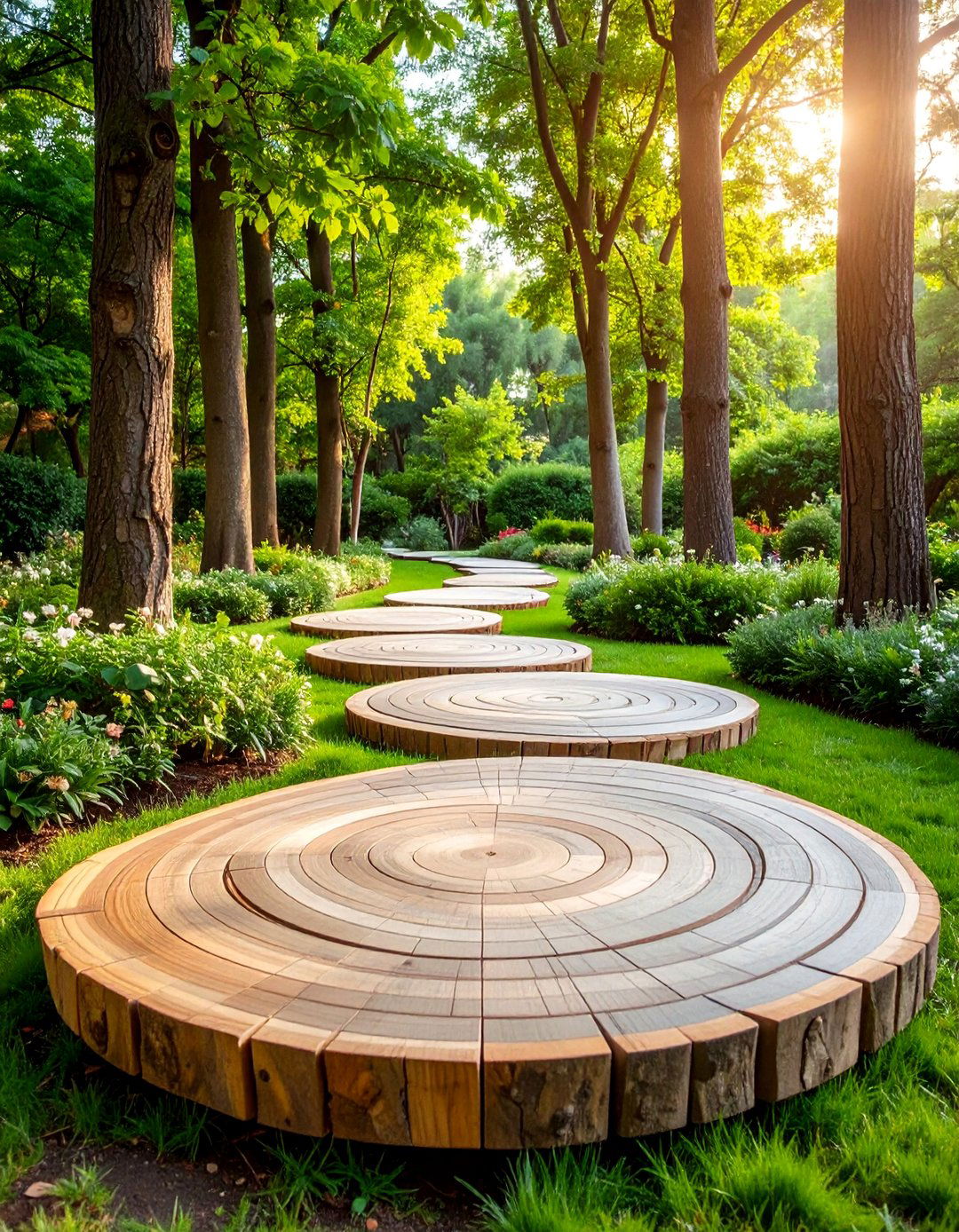

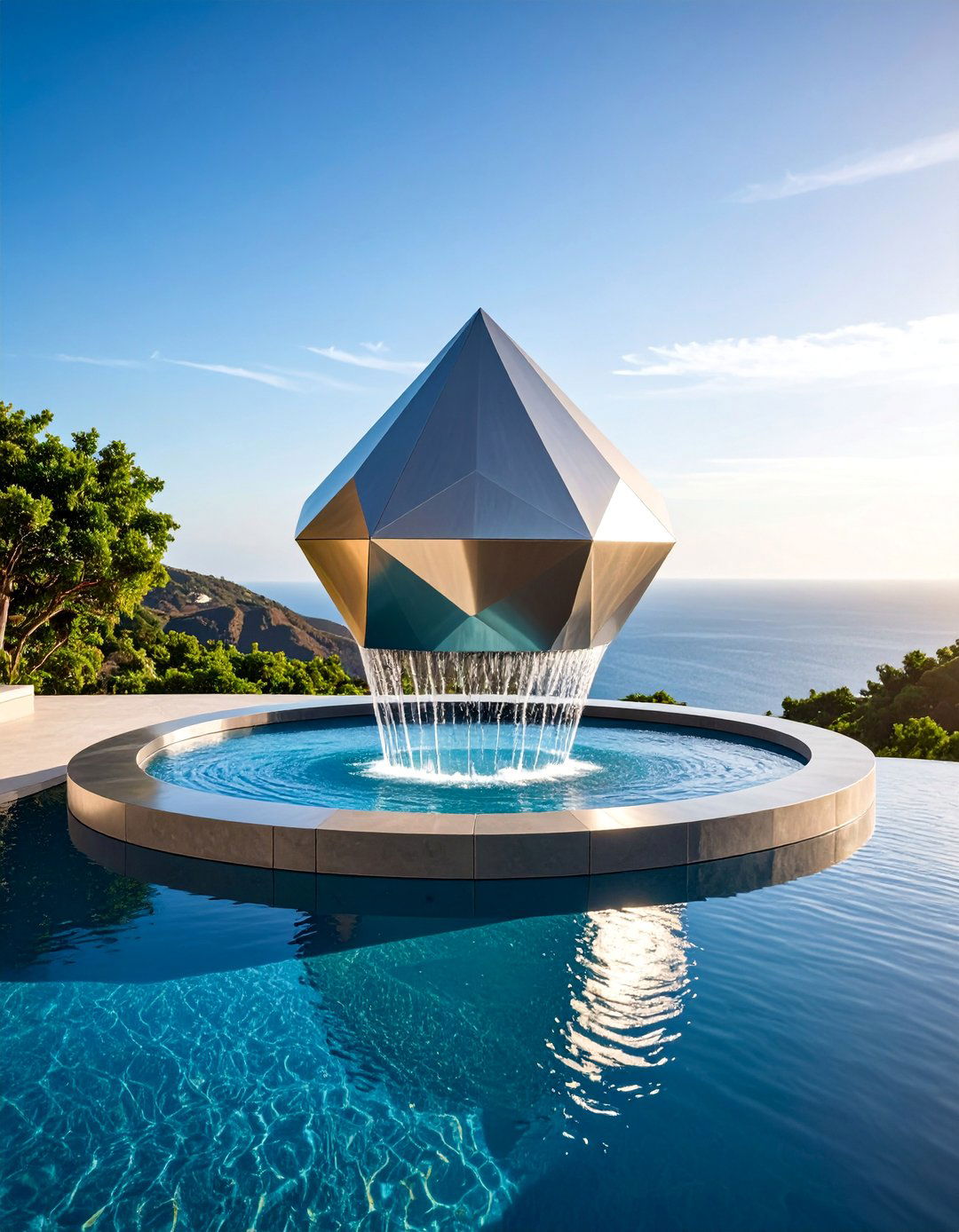

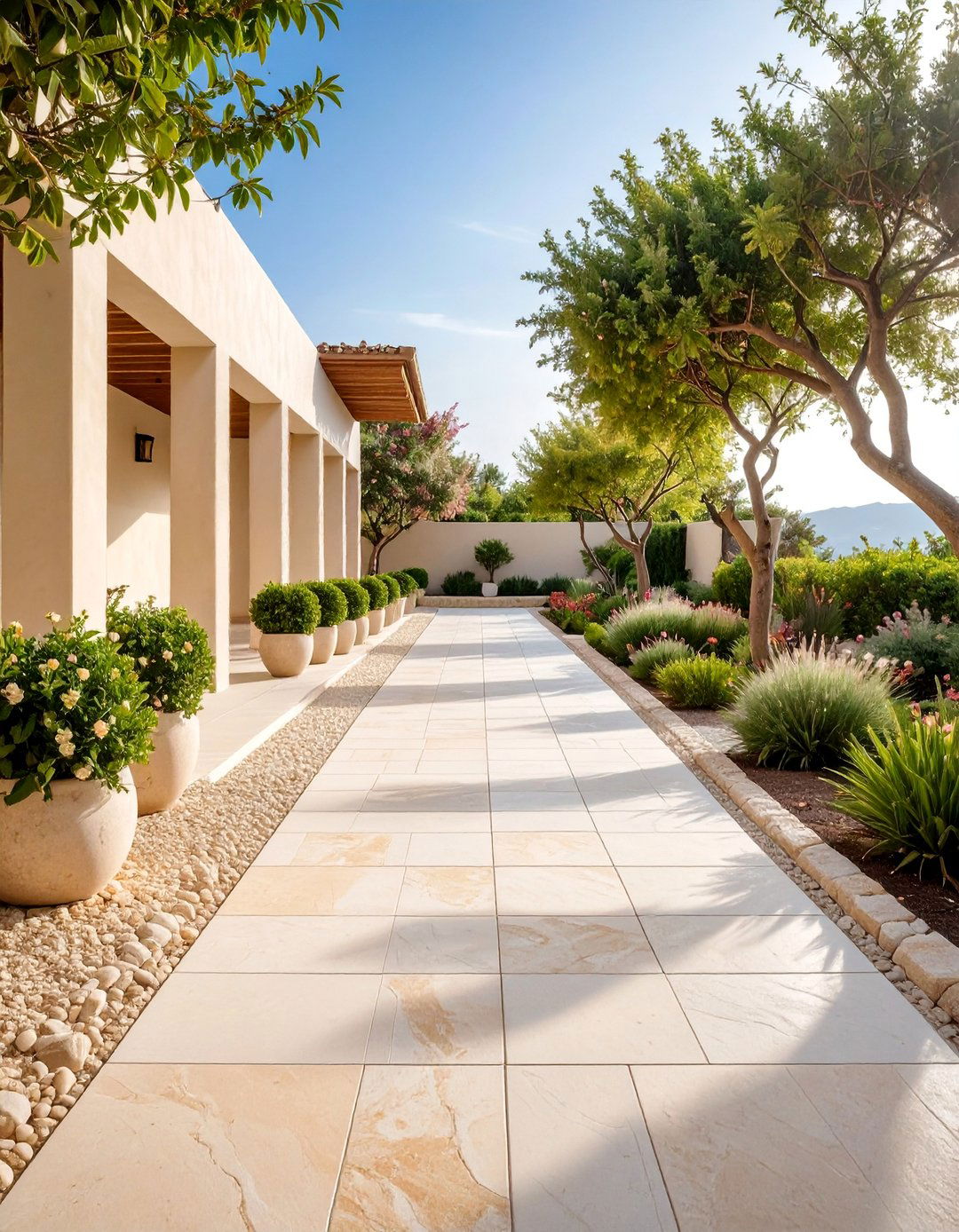
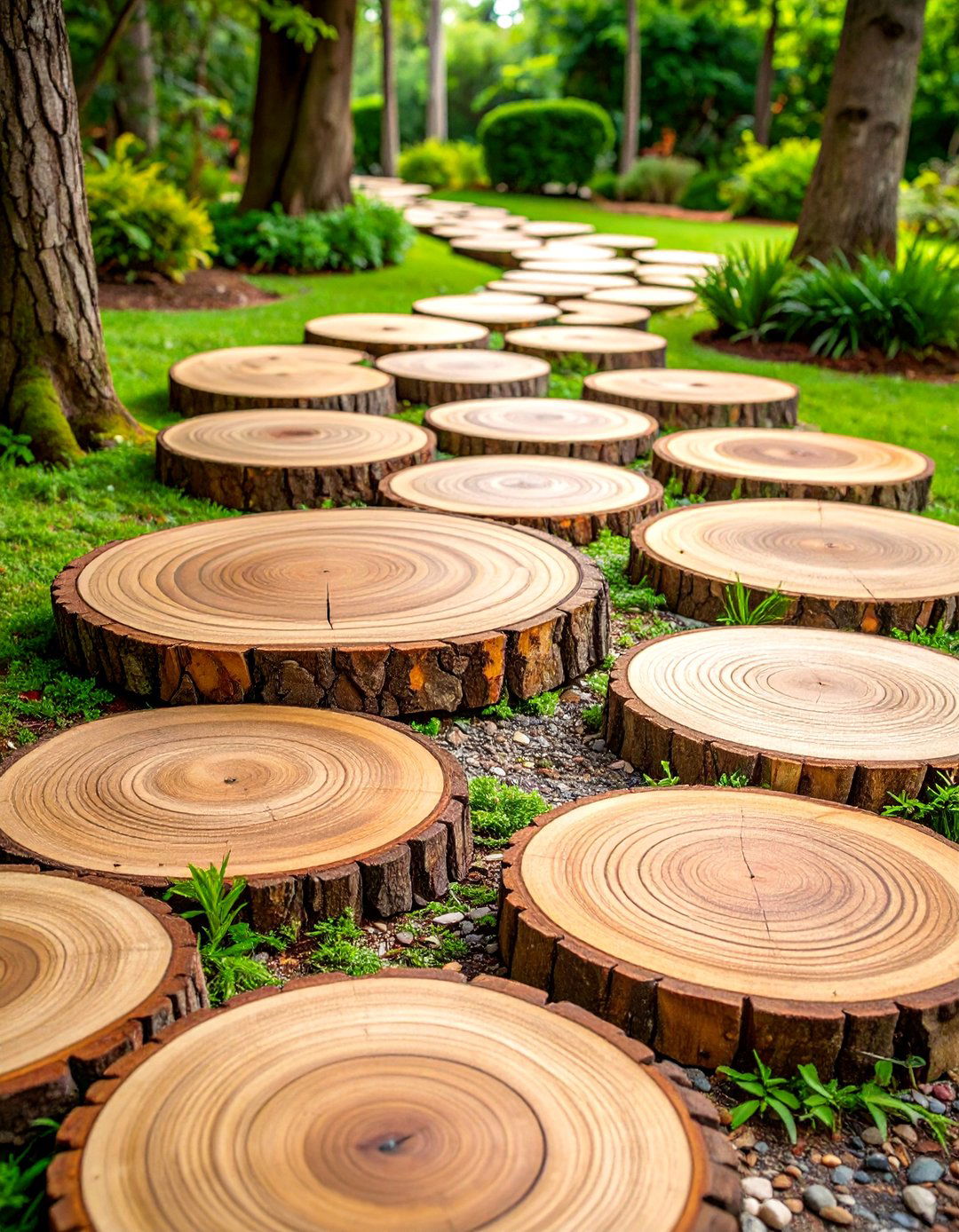







Leave a Reply